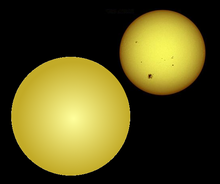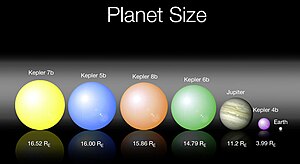| Observation data Epoch J2000 Equinox J2000 | |
|---|---|
| Constellation | Cygnus |
| Right ascension | 19h 47m 20.9380s[1] |
| Declination | +48° 14′ 23.759″[1] |
| Apparent magnitude (V) | 13.8 |
| Characteristics | |
| Apparent magnitude (J) | 12.001±0.021[2] |
| Apparent magnitude (H) | 11.706±0.019[2] |
| Apparent magnitude (K) | 11.634±0.019[2] |
| Astrometry | |
| Proper motion (μ) | RA: 0.935(11) mas/yr[1] Dec.: 8.458(12) mas/yr[1] |
| Parallax (π) | 1.7108 ± 0.0102 mas[1] |
| Distance | 1,910 ± 10 ly (585 ± 3 pc) |
| Details | |
| Mass | 1.209 M☉ |
| Radius | 1.391 R☉ |
| Temperature | 5647 K |
| Age | 3.8 Gyr |
| Other designations | |
| Database references | |
| SIMBAD | data |
| KIC | data |
Kepler-6 is a G-type star situated in the constellation Cygnus. The star lies within the field of view of the Kepler Mission, which discovered it as part of a NASA-led mission to discover Earth-like planets. The star, which is slightly larger, more metal-rich, slightly cooler, and more massive than the Sun, is orbited by at least one extrasolar planet, a Jupiter-sized planet named Kepler-6b that orbits closely to its star.

Nomenclature and history
[edit]Kepler-6 was named for the Kepler Mission, a NASA project launched in 2009 that aims to discover Earth-like planets that transit, or cross in front of, their home stars with respect to Earth.[4] Unlike stars like the Sun or Sirius, Kepler-6 does not have a common and colloquial name. The discovery of Kepler-6b was announced by the Kepler team on January 4, 2010[5] at the 215th meeting of the American Astronomical Society along with planets around Kepler-4, Kepler-5, Kepler-7, and Kepler-8.[6] It was the third planet to be discovered by the Kepler spacecraft; the first three planets to be verified by data from Kepler had been previously discovered. These three planets were used to test the accuracy of Kepler's measurements.[7]
The discovery of Kepler-6 was confirmed by follow-up observations made using the Hobby–Eberly and Smith telescopes in Texas; the Keck 1 telescope in Hawaii; the Hale and Shane telescopes in southern California; the WIYN, MMT, and Tillinghast telescopes in Arizona; and the Nordic Optical Telescope in the Canary Islands.[8]
Characteristics
[edit]Kepler-6 is a star that is approximately 1.209 Msun, or some five-fourths the mass of the Sun. It is also wider than the sun, with a radius of 1.391 Rsun, or seven-fifths of that of the Sun. The star is approximately 3.8 billion years old, and has an effective temperature of 5647 K (9,705 °F).[9] In comparison, the Sun has a slightly warmer temperature of 5778 K.[10] Kepler-6 has a metallicity of [Fe/H] = +0.34, making it 2.2 times more metallic than the Sun.[7] On average, metal-rich stars tend to be more likely to have planets and planetary systems.[11]
The star, as seen from Earth, has an apparent magnitude of 13.8.[7] It is not visible with the naked eye. In comparison, Pluto's apparent magnitude at its brightest is slightly brighter, at 13.65.[12]
Planetary system
[edit]
Kepler-6 has one confirmed extrasolar planet; it is a gas giant named Kepler-6b.[13] The planet is approximately .669 MJ, or some two-thirds the mass of planet Jupiter. It is also slightly more diffuse than Jupiter, with a radius of approximately 1.323 RJ. Kepler-6b orbits at an average distance of .0456 AU from its star, and completes an orbit every 3.234 days. The eccentricity of the planet's orbit is assumed to be 0, which is that of a circular orbit.[9]
| Companion (in order from star) |
Mass | Semimajor axis (AU) |
Orbital period (days) |
Eccentricity | Inclination | Radius |
|---|---|---|---|---|---|---|
| b | 0.669 MJ | 0.04567 | 3.2347 | 0 | — | 1.323 RJ |
See also
[edit]References
[edit]- ^ a b c d Vallenari, A.; et al. (Gaia collaboration) (2023). "Gaia Data Release 3. Summary of the content and survey properties". Astronomy and Astrophysics. 674: A1. arXiv:2208.00211. Bibcode:2023A&A...674A...1G. doi:10.1051/0004-6361/202243940. S2CID 244398875. Gaia DR3 record for this source at VizieR.
- ^ a b c Skrutskie, Michael F.; Cutri, Roc M.; Stiening, Rae; Weinberg, Martin D.; Schneider, Stephen E.; Carpenter, John M.; Beichman, Charles A.; Capps, Richard W.; Chester, Thomas; Elias, Jonathan H.; Huchra, John P.; Liebert, James W.; Lonsdale, Carol J.; Monet, David G.; Price, Stephan; Seitzer, Patrick; Jarrett, Thomas H.; Kirkpatrick, J. Davy; Gizis, John E.; Howard, Elizabeth V.; Evans, Tracey E.; Fowler, John W.; Fullmer, Linda; Hurt, Robert L.; Light, Robert M.; Kopan, Eugene L.; Marsh, Kenneth A.; McCallon, Howard L.; Tam, Robert; Van Dyk, Schuyler D.; Wheelock, Sherry L. (1 February 2006). "The Two Micron All Sky Survey (2MASS)". The Astronomical Journal. 131 (2): 1163–1183. Bibcode:2006AJ....131.1163S. doi:10.1086/498708. ISSN 0004-6256. S2CID 18913331. Vizier catalog entry
- ^ "Kepler-6". SIMBAD. Centre de données astronomiques de Strasbourg. Retrieved 2019-11-29.
- ^ "Mission overview". Kepler and K2. NASA. 13 April 2015. Retrieved 7 August 2020.
- ^ Alexander J. Willman Jr. (5 January 2010). "Kepler 6 Planetary System". Princeton University. Retrieved 19 February 2011.
- ^ Rich Talcott (5 January 2010). "215th AAS meeting update: Kepler discoveries the talk of the town". Astronomy.com. Astronomy magazine. Retrieved 19 February 2011.
- ^ a b c d "Summary Table of Kepler Discoveries". NASA. 2010-08-27. Archived from the original on 2010-05-27. Retrieved 2010-10-16.
- ^ "NASA's Kepler Space Telescope Discovers its First Five Exoplanets". NASA. 4 January 2010. Archived from the original on 4 April 2012. Retrieved 26 February 2011.
- ^ a b "Notes for star Kepler-6". Extrasolar Planets Encyclopaedia. 2010. Archived from the original on 21 January 2011. Retrieved 19 February 2011.
- ^ Fraser Cain (September 15, 2008). "Temperature of the Sun". Universe Today. Retrieved 19 February 2011.
- ^ Charles H. Lineweaver (2001). "An Estimate of the Age Distribution of Terrestrial Planets in the Universe: Quantifying Metallicity as a Selection Effect". Icarus. 151 (2): 307–313. arXiv:astro-ph/0012399. Bibcode:2001Icar..151..307L. doi:10.1006/icar.2001.6607. S2CID 14077895.
- ^ "Pluto Fact Sheet". Goddard Space Flight Center. NASA. 17 November 2010. Retrieved 24 February 2011.
- ^ Dunham, Edward W.; et al. (2010). "Kepler-6b: A Transiting Hot Jupiter Orbiting a Metal-rich Star". The Astrophysical Journal Letters. 713 (2): L136–L139. arXiv:1001.0333. Bibcode:2010ApJ...713L.136D. doi:10.1088/2041-8205/713/2/L136.